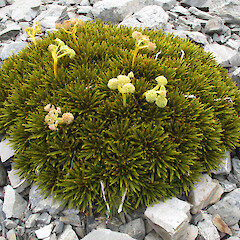Aciphylla dobsonii
Common name
Dobson’s speargrass
Family
Apiaceae
Flora category
Vascular – Native
Endemic taxon
Yes
Endemic genus
No
Endemic family
No
Structural class
Herbs - Dicotyledons other than Composites
NVS code
The National Vegetation Survey (NVS) Databank is a physical archive and electronic databank containing records of over 94,000 vegetation survey plots - including data from over 19,000 permanent plots. NVS maintains a standard set of species code abbreviations that correspond to standard scientific plant names from the Ngä Tipu o Aotearoa - New Zealand Plants database.
ACIDOB
Chromosome number
2n = 22
Current conservation status
The conservation status of all known New Zealand vascular plant taxa at the rank of species and below were reassessed in 2017 using the New Zealand Threat Classification System (NZTCS) – more information about this can be found on the NZTCS website. This report includes a statistical summary and brief notes on changes since 2012 and replaces all previous NZTCS lists for vascular plants.
Please note, threat classifications are often suggested by authors when publications fall between NZTCS assessment periods – an interim threat classification status has not been assessed by the NZTCS panel.
- Conservation status of New Zealand indigenous vascular plants, 2017 . 2018. Peter J. de Lange, Jeremy R. Rolfe, John W. Barkla, Shannel P. Courtney, Paul D. Champion, Leon R. Perrie, Sarah M. Beadel, Kerry A. Ford, Ilse Breitwieser, Ines Schönberger, Rowan Hindmarsh-Walls, Peter B. Heenan and Kate Ladley. Department of Conservation. Source: NZTCS and licensed by DOC for reuse under the Creative Commons Attribution 4.0 International licence.
2017 | Not Threatened | Qualifiers: DP
Previous conservation statuses
2012 | Not Threatened
2009 | Not Threatened
2004 | Not Threatened
Distribution
Endemic. South Island, higher greywacke montane to subalpine areas of south Canterbury to north Otago.
Habitat
Confined to fellfield, (1500-2200 m.a.s.l.) especially along exposed ridge crests, where it may be the most conspicuous plant.
Detailed description
Distinctive stocky herb, close-set rosettes up to 150 mm in diameter forming a cushion-like plant up to 1 m across, taproot up to 20 mm diameter, deeply descending. Leaf-sheaths approximately 50 x 15 mm, thick, rigid; margins cartilaginous. Stipules approximately 20 mm long, approximately 3 mm wide at base, tapering to a hard sharp point. Lamina rigid, coriaceous, slightly longer than stipules, with spinose apex approximately 10cm long. Flowering stems stout, grooved, up to approximately 30 cm tall including the subcapitate inflorescence. Primary rays 4-5, short, stout; umbels and umbellules crowded; bract-sheaths up to 40 x 20 mm, with stipules and lamina up to 50 mm long and 9 mm wide at base. Fruit narrow-oblong, up to 3.5 mm long; mericarps 4-5 winged.
Similar taxa
Aciphylla leighii smaller plant than A. dobsonii; leaves are only about 5 cm long, leaf tips are generally more blunt, peduncles are rather slender compared to stout in A. dobsonii.
Flowering
December - January
Fruiting
February – March
Life cycle
Winged schizocarps are dispersed primarily by wind (Thorsen et al., 2009).
Propagation technique
Difficult. Possibly due to the large lengthy taproot and need for scree habitat (Dawson & LeComte).
Etymology
aciphylla: From the Latin acicula ‘needle’ and the Greek phyllum ‘leaf’, meaning needle-leaf.
dobsonii: Dobson: After Mount Dobson near Lake Tekapo, the type location for this species.
Attribution
Description adapted by M. Ward from Allan (1961).
References and further reading
Allan, H. H. 1961. Flora of New Zealand. Vol. 1. Wellington: Government Printer. pg. 469-470.
Dawson, J.W. LeComte, J.R. 1978. Research on Aciphylla - a progress report. Tuatara 23: pg. 49-67.
Mark, A. F. 2012. Above the Treeline: A Nature Guide to Alpine New Zealand. Craig Potton Publishing, Nelson. pg. 150.
Thorsen, M. J.; Dickinson, K. J. M.; Seddon, P. J. 2009. Seed dispersal systems in the New Zealand flora. Perspectives in Plant Ecology, Evolution and Systematics 2009 Vol. 11 No. 4 pp. 285-309









